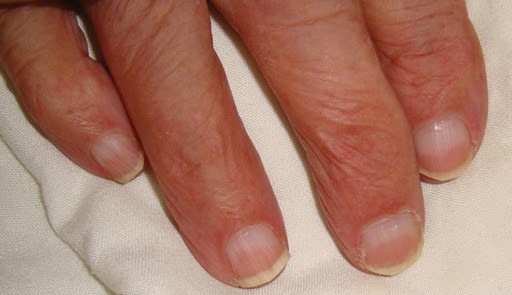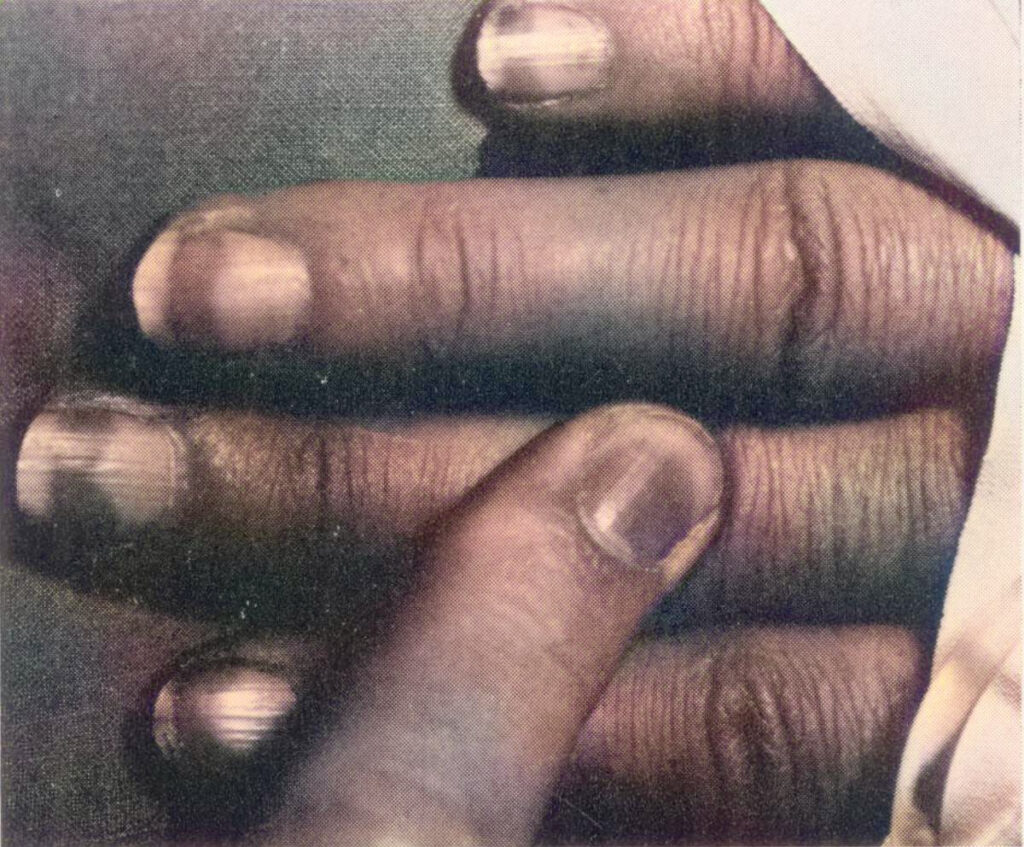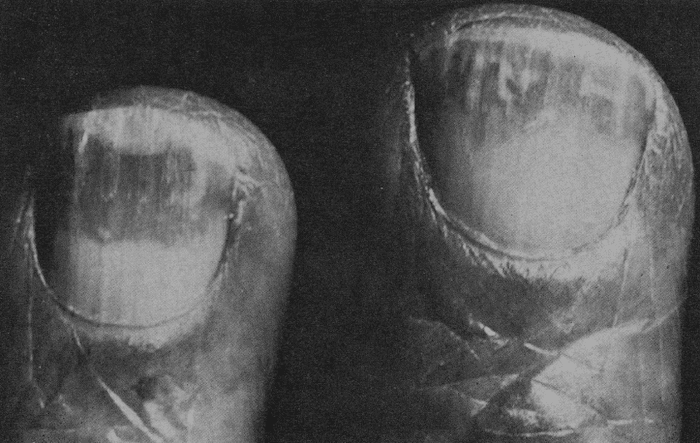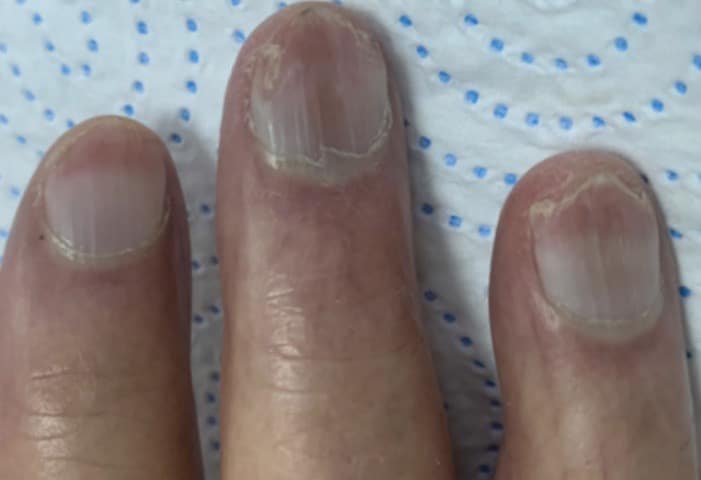Lindsay nails
Lindsay nails (half-and-half nails) is an apparent leukonychia of the proximal portion of the nail which is white and distinct from the reddish brown distal band, which occupies the remaining 20-60% of the nail bed.
First reported by Bean in 1963, the systemic onychopathy occurs with various chronic diseases, most commonly in chronic renal failure but may also be seen in normal individuals. Most common associations include , Kawasaki disease, cirrhosis, zinc deficiency, Crohn’s disease and chronic renal disease
Half-and-half nails are characterised by a sharply demarcated nail bed change – the proximal portion of each nail bed as pale/white and the distal portion red, pink, or brown. In addition to the nail-bed change, there may also be associated the presence of melanin in the acral part of the nail plate itself, thus involving a second component of the nail unit.
The pigmentary nail changes are identified in patients with uraemia and, although not pathognomonic, is a specific clinical marker of chronic renal failure being found in approximately 40% of cases of end stage kidney disease.
The half-and-half nail pattern is persistent, with no tendency of the bands to move with nail growth. These nail findings are thought to be present in up to one third of patients starting haemodialysis. This sign may disappear completely after successful kidney transplantation but usually remains unchanged with haemodialysis.

Chang. Ungual dyschromia 2013
History of Lindsay nails
1962 – A reddish discoloration of the distal nail was noted in two patients with azotemia by Bill Bean and James Clifton in 1962.
In 1962, Dr. James Clifton and I observed two patients who had the extraordinary abnormality depicted in Figure 6. Between a third and almost a half of the distal portion of the nail they had a red, slightly orange color. Most of this color faded out when the free edge of the nail was pressed though the area which had been red was still distinguished by a gray color. Both patients with this nail lesion had renal disease. One died of uremia. The other had only moderate renal failure associated with prolonged diabetes.
Bean 1963

1965 – Philip G. Lindsay reviewed four similar cases in 1963 and 1964, with azotemia and a distinctive nail color. pattern. He termed the examination finding as half-and-half nail, as the proximal portion of each nail bed was white and the distal portion red, pink, or brown, but always sharply demarcated. He published a preliminary report describing the first 20 cases in 1965
1967 – Lindsay reviewed 1,500 patients on the general medical wards/ clinics of Iowa Hospitals were examined for nail abnormalities during the period of July 1964 to January 1966.
A new nail syndrome, designated the half-and-half nail, has been observed in 25 patients. Twenty-four of these patients had evidence of renal disease and 21 had azotemia. The pattern of proximal nail bed whiteness and distal nail bed red, pink, or brown band occupying 20% to 60% of nail length should alert one to the possibility of azotemia. This pattern seems distinct from that white nail of cirrhosis described by Terry.
Lindsay 1967

Patient (4) with moderately severe nephrosclerosis and creatine clearance of 10 ml/min
Lindsay described how there was no correlation between the severity of azotemia and distal band length, and no pattern for sex, age or cause of renal failure found.
1968 – Baran and Gioanni considered a hypothesis for this nail change.
The uremic substances may stimulate melanocytes leading to increased melanin deposition in the distal half of nail. But there is no correlation between the amount of retained uremic substances in the body and the length of transverse band. Furthermore, this nail discoloration may not regress with haemodialysis.
1972 – Leyden and Wood tried to provide a histological examination of these nail changes through looking at one patients nail biopsies.
It is suggested that rapid renal decompensation with subsequent acidosis and elevation of the toxic substances or uremia may stimulate melanin formation by the melanocytes of the nail matrix.
Leyden and Wood 1972
Other explanations include increased nail bed capillary density and thickening of capillary walls. Ultimately the aetiology is not known but is thought to be related to uraemia.
2021 – Aouali et al report the first description of acute onset of half and half nails during COVID-19 severe infection in 2 patients suggesting that it could be considered as a severity marker.

Associated Persons
- William B. Bean (1909-1989)
- Philip G. Lindsay (1937 – 2017)
- James J. Leyden
- Margaret Gray Wood
Alternative names
- Half and half nails; Half-and-half nails
- Lindsay’s nails
Other eponymous nail signs
- Beau’s lines
- Lindsay’s nails (apparent leukonychia)
- Mees lines (true leukonychia)
- Muehrcke lines (apparent leukonychia)
- Terry’s nails (apparent leukonychia)
References
Original articles
- Bean WB. A Discourse on Nail Growth and Unusual Fingernails, Transactions of the American Climatological and Clinical Association. 1963; 74: 152-167, 1963.
- Bean WB. Nail growth. A twenty-year study. Arch Intern Med. 1963; 111: 476‐482.
- Lindsay PG. The Half and Half Nail, J Lab Clin Med 1965; 66: 892
- Lindsay PG. The half-and-half nail. Arch Intern Med. 1967; 119(6): 583‐587.
Review articles
- Baran R, Gioanni T. Half-and-half nail (l’ongle équi-segmenté azotémique). Bulletin de la Société française de dermatologie et de syphiligraphie. 1968; 75(3): 399‐400.
- Zágoni T, Sipos F, Tarján Z, Péter Z. The half-and-half nail: a new sign of Crohn’s disease? Report of four cases. Dis Colon Rectum. 2006 Jul;49(7):1071-3
- Chang P. Ungual Dyschromia. Our Dermatol Online. 2013; 4(4): 549-552
- Pitukweerakul S, Pilla S. Terry’s Nails and Lindsay’s Nails: Two Nail Abnormalities in Chronic Systemic Diseases. J Gen Intern Med. 2016 Aug;31(8):970.
- Madhyastha S, Gopalaswamy V, Acharya R, Bekur R. Half and half nail or Lindsay’s nail: An overlooked physical finding in chronic kidney disease. AMJ 2016;9(6):194–196
- Aouali S, Sefraoui S, Zizi N, Dikhaye S. Half and half nail, is it a marker of severe COVID-19 infection? Ann Med Surg (Lond). 2021 Nov;71:102963.
- Cadogan M. Lindsay Nails. Eponym A Day. Instagram
[cite]
eponymictionary
the names behind the name
RN, Sir Charles Gairdner Hospital. Coronary Care Unit // Emergency Department. Keen interest in critical and pre hospital care.

